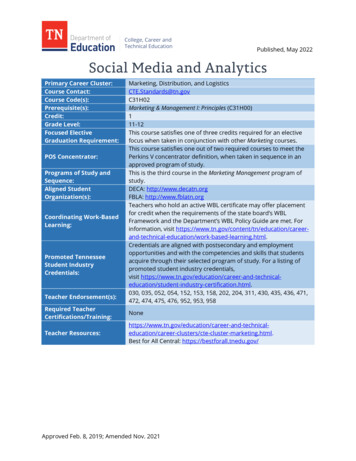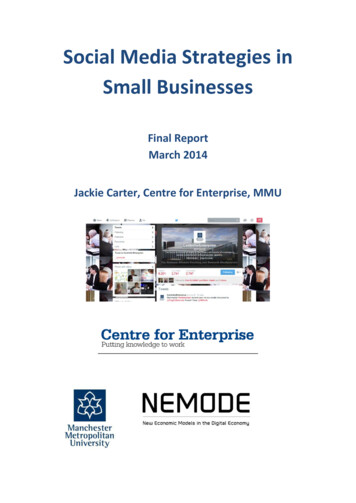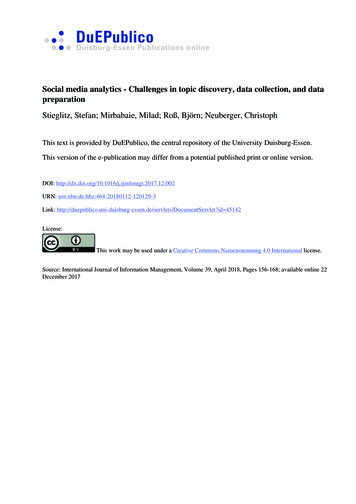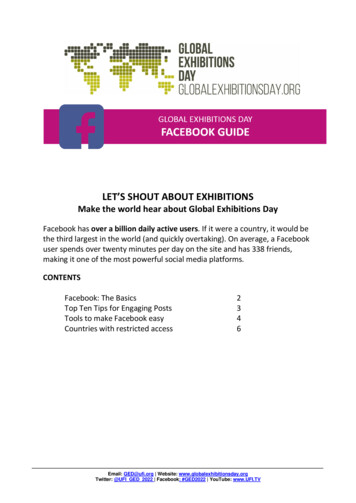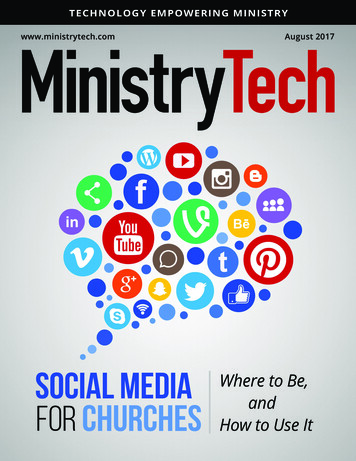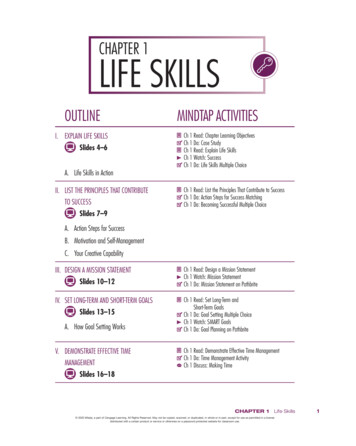
Transcription
Studia Ekonomiczne. Zeszyty NaukoweUniwersytetu Ekonomicznego w KatowicachISSN 2083-8611Nr 234 · 2015Beata HysaAnna MularczykPolitechnika Śląska w GliwicachWydział Organizacji i Zarządzaniabeata.hysa@polsl.plPolitechnika Śląska w GliwicachWydział Organizacji i Zarządzaniaanna.mularczyk@polsl.plIwona ZdonekPolitechnika Śląska w GliwicachWydział Organizacji i Zarządzaniaiwona.zdonek@polsl.plSOCIAL MEDIA – THE CHALLENGESAND THE FUTURE DIRECTION OF THE RECRUITMENTPROCESS IN HRM AREASummary: During over the last few years, the world of communication has been changing rapidly. The Internet and modern information technologies have led to the increasingpopularity and using social media in different areas: in communication, new markets,new businesses, advertising and promotion companies.The main purpose of this article is to show the possibility of using social media inrecruitment process and to present the impact of social media on Human Resource Management. Over 150 respondents, who participated in the research, help us explore therisks and benefits of using social media by employees for the organization’s reputation,and deliver suggestions for Human Resource Management policy.Keywords: social media, HRM, recruitment process.IntroductionThe rapid development of information and communication technologies haschanged functioning of the enterprises, banks, government, and ordinary people.Companies and organizations are aware of the power of social media and increasingly implement this new tool into their marketing strategies. At the sametime, the social networking system provides some space for marketing activitiesin a very sophisticated and effective way. The company profiles on social net-
Social media – the challenges and the future direction 55works provide a space for users in which they discuss their favourite brands andalso create an effective platform – an online communication channel for the implementation of marketing communication [Štefko et al., 2014].The social media are defined as series of technological innovations in termsof both hardware and software that facilitate inexpensive content creation, interaction, and interoperability by online users [Berthon et al., 2012]. Social mediacan be described as “a group of Internet-based applications that build on theideological and technological foundations of Web 2.0, and that allow the creation and exchange of user-generated content.” [Andreas, Kaplan, 2010].A typical classification of social media includes collaborative projects (e.g.Wikipedia), blogs, user-generated content communities (e.g. Flickr; YouTube),social networking sites (e.g. Facebook; Twitter), virtual game worlds (e.g. EverQuest), and virtual social worlds (e.g. Second Life) [Andreas, Kaplan, 2010].This paper presents the growing influence of social media in recruitmentprocess. The own study allows to describe the advantages and disadvantages ofusing social media by employees for the organization’s reputation, and to provide suggestions for Human Resource Management policy.1. The impact of social media on Human Resource ManagementSocial media have become a bigger part of our private and professional life.They create making new possibilities in our different activities. The popularityof the social media sites is phenomenal in recent years. The using of the socialmedia by companies for marketing, promotion and image is described very wellin the literature [Agresta, Bonin, 2011; Goodman, Hirsch, 2010; Fed Ex &Ketchum, 2012; Okazaki, Taylor, 2013]. However, the growing popularity of social media enforced changing not only in business environment, strategies andadvertising but also in government administration [Bonsóna et al., 2012], banking industry [Bonsóna, Flores, 2011], tourism [Yazdanifard, Lim Tzen Yee,2014] and Human Resource Management [Sander van Lingen, 2012].Over the past few years, we have kept tracking the impact of social mediaon the HRM, especially in the recruiting area. Currently, traditional methods ofrecruitment have been revolutionized by the tools offered by social media and bythe Internet. The recruitment is a process of finding and attracting capable applicants for employment. The Internet in e-recruiting is used to attract candidatesand aid the recruitment process. This usually means using one’s own companywebsite, a third-party job site or job board, a CV database, social media orsearching engine marketing [Palonka, Porębska-Miąc, 2014].
56Beata Hysa, Anna Mularczyk, Iwona ZdonekToday, many businesses decide to implement the recruitment process withtheir help. Such decisions are motivated by the following reasons [Palonka,Porębska-Miąc, 2014]:– convenience of using social networking services,– greater awareness of the benefits which may be gained through social mediatools,– a possibility to update job offers depending on vacancies available– access to potential employees – Internet users have their own profiles in atleast one social networking which they regularly visit and update their personal information,– job instability and related difficulties in predicting the need to look for newemployment,– easy tracking of attractive job offers, by following up on recruiters’ profiles.The development of social media encourages HRM department to takea different look at the methods and practical way of searching new candidatesfor job. Traditional CVs sent by mail, faxed or attached to emails are now givingground to social media recruiting. Social networks offer great opportunities forrecruiters who want to get qualified candidates Instead of using simply searchingfor candidates they use search engine, blogs, RSS, tagging, social networking,community interaction and multimedia. It is very important especially becausefor growing employees of Generation Y1 on the labor market. They are the firstgeneration which has spent entire life in the digital environment; informationtechnology profoundly shows how they live and work [Bennett, et al., 2008].Interesting information about the perception of the role and the impact ofsocial networks in the recruitment process delivers a report from Jobvite SocialRecruiting Survey 20142.12The categorization of generations, using the following birth dates: the Silent Generation (19251945), the Baby Boomers (1946-1960), Generation X (1961-1981) and Generation Y (19811999). (Ruth et. al., 2013).The online survey was conducted in August 2014. The survey was completed by 1,855 recruiting and human resources professionals spanning across industries.
SSociial mmeddia – thee chhallengges anda d thee futture dirrectiion 57W ch ofWhico thhe follof owiing taccticss doo yoou useu forr reccruttingg onn soocialnettwoorkss ?Twittter3 %32%Generatee emmployyee refeerrals51%%44%%Shoowcaase empe ployeer brandd3 %39%Postt jobbs188%Vett canndiddatees poost-interrviewwVeet caandiidates pre-ip nterrviewwFaceeboookLinkkedInn559%%48%4922%35%%3 %32%933%Keeep taabs on potep entiaal caandiddatees933%ntacct caandiddateesCon995%17%Seearch foor caandiddatees995%0%%200%440%60%6 %80%% 1000%F . 1. Difffereent ttypees oof taacticcs inn HRFig.RM depparttmenntS ce: [wwwSour[ w1].Thhe rreport is a suummmarry oof reser earcch condc ducctedd evveryy yeear in thet USSA. Accccorddingg thhe survs vey 93% ofo recrr ruiters useed oro planp nned too usse socis ial medm dia to suppp t thheir reccruitingportg effforrts whiw ich is aan inncrreasse ofo 133%% comppareed too 200100. HRMH Md partmdepmennt expe loitted difffereent tacctics foor recrr ruitiing off socciall neetwworkks (FFigg. 1)),l e: poost joblikeb (992%% onn LinkkedIIn, 48%4 % ono FaceF eboook,, 399% on Twwitteer), vett caandiid es predatep -inttervvieww (93%% ono LinnkedInn, 32%3 % on FFaceboook)) oor postp t-inttervvieww( % on(35%o FFacceboookk, 188% on Twwitteer).M e thMorehan 70%% oof recrr ruiteers plaanned to grog w ttheiir innveestmmentt inn soociaal reec iting in the futturee. HRMcruiH M ddeppartmmennt taket es soccial meediaa proffiless seerioousllyw en canwhec ndiddatees area eevaaluaatedd. RecrR ruitters aree noow revviewwinng ssociial proofilees ttou coveer muncmuttuall coonnnectionns aand evaluate wrritteen oor desd signn wworkk. 55%5 % off reec iterrs reeconcruinsiddereed a caanddidaate baseb ed ono their socis ial profp filee (133% upp onn 20013)).7 % of73%o reecruuiteers hireed a candc didaate thrrouggh soccial meediaa. TheT LinkeedInn iss thhem st popmosp pulaar social nnetwworrk which coomppaniies hirre worw rkerrs ((79%%),, annd theenF ceboookk (26Fac6%%), TwitT tterr (166%%).TThe studdy alsoo caarriied outt thaat 993%% off recruuiterrsw l reevieew a caandwilldidaate’ss soociaal profifile befforee makim ng a hirinh ng ddeccisioon. Moostllyt y loookeed fortheyf proofesssioonall exxperriennce,, lenngthh of prrofeessiionaal teenuure or sspecifiich d skkillss (FhardFig. 2).
558Beeataa Hyysa, Annna MMularcczykk, Iwwonna ZdonZ nekF . 2. Whhat empFig.e ployyers are loookinng foor inn caandiidatee onn soociall neetwoorkssS ce: [wwwSour[ w1].2 Dis2.D advvanntaagess off ussinng ssociial meediaaThhe iimpporttancce oof socis ial mmeddia, ass a sous urcee off knnowwleddge aboout thee caandiid es inn thhe recrdater ruitmmennt procp cess, is raapiddly inccreaasing. TheT e Internnet useers’ awwareen s off thhe imnessmpoortaancee off thhe conttentt givvenn onn thhe soociaal netwn worrkinng sitess orr annyo er “traothe“ acess” left by theem onn thee wweb shoulld growg w ata a simmilaar rater e [PPaloonkaa,P rębsska--Miiąc, 20Por014]]. CanC ndiddatees aappllyinng forf a job shoouldd taake caare oof theit iri age on thee Innternimanet, paayinng ppartticuularr atttenttionn to thee coonteent theey placp ce thert rea itasi maym be seeen byb ppottenttial emmplooyerrs. Theese conntennts maay bbothh heelp to finnda joob anda preevennt fromf m it. Foor eexammplle, a siinglle mumm m wasw fireed ffromm her nneww jooba a daaycaare cennterr aftter shee poosteed oon FaceatF eboook thaat shhe “ha“ atedd” itt. TheT womaanw s toold by herr bowasoss, whow reaad thet poost, nott too tuurn up forr heer firstf t shhift jussth urs befforee shhe washouw s duue to starrt [[Riddleyy, 2012 5]. Noot onlyo y fuuturre empe ployyeeess uldd bee caarefushouful aboua ut whaw at innformaatioon theyt y leavee onn soociaal nnetwworkks bbut alssop entiial empotemplooyerrs nneed tot cconttroll thhe infoi ormmatioon posstedd onn thheirr wwebsiteesc mpaaniees. IntecomI erneet uuserrs, whiw ile prepp parringg to inttervviewws, aree loookiing forr a preec us knociouk owleedgge aboua ut potep entiial empe ployyerrs’ in thheirr seerviicess (faan pagp ges, miicroob gs, andd toblogopicc rellateed foruf umss). MorM reovverr, innformmattionn fooundd onlinne helph ps themt mt creatoc ate ttheiir owwn immagee off orggannizaationns, bussineess cullturee, etc.e
Social media – the challenges and the future direction 59The consequences of the using of social media by companies can also bringsome disadvantages. Social media can have a negative influence on workers’ productivity. Employees may waste valuable time using social media sites such asFacebook and Twitter. They can also use social media to attack the company’s reputation. Rude, unwelcome and negative comments made by a company’s employeescan really generate a negative image for the company and their brand. In the worstcase scenario, an employee’s social networking actions could actually have longlasting and devastating effects on the company’s brand and image. Therefore, companies should establish some rules for using social media in workplace.3. Rules of using social media in workplaceThe scientists and practitioners are aware of the importance of employees’social media use for the reputation management process. There are many suggestions on how organizations should manage risks and benefits of their employees’participation in social media in order to protect their reputation, but they oftenfocus on tactical measures, rather than on strategic management [Dreher, 2014].Employers have the right to simply ban on all computers activities that arenot work-related, but this approach may not yield optimal results. If employeesare allowed to access to social networking platforms, then a comprehensive andwell-defined policy should be established to prevent abuse. Without frameworkfor determining what is proper for use of the social media in the workplace,companies have to rely on a trial-and-error approach to social media etiquette.All employees should sign policies related to the use of the Internet at work, access to social networking sites and what they are allowed to say or do during office hours. Monitoring of all Web activities is important, and employees shouldbe aware that their actions are being recorded and that failure to adhere to company policy can result in disciplinary action and/or dismissal.Some companies may face challenges striking the right balance betweenconducting a successful recruitment exercise on social media and protecting thebrand image. For example, when a firm posts a job opening on social media, itmay receive numerous applications and choose to contact one or two prospectivecandidates. Applicants who are not contacted could react angrily and post damaging information about the firm on numerous social networks. Talented jobseekers may also ignore job openings posted by companies with poor social media profiles. Such firms can, however, hire reputation management specialists tohelp build a positive image.
60Beata Hysa, Anna Mularczyk, Iwona Zdonek4. MethodologyIn order to explore the impact of social media on Human Resource Management policy in Polish organizations – as well as the awareness of it – anonline survey was conducted among both employees and employers in May2015. The questionnaire consisted of 7 closed questions which responses weremeasured on a nominal scale. The queries were dedicated particularly to employees. We inquired about ways of finding a job, including – among others –the one associated with social network. We investigated also if they took into anaccount that employers could visit their profiles. We wanted to know whetherthey are aware that the included information could affect their career. We askedalso if employers forbade them to put some information on their private profiles,if they required them to apply the special principles or if they should block atwork the employee’s access to some websites, especially to social networks. Thequestionnaire included also the question about sociodemographic data.The invitation to the survey was distributed by e-mail. The population ofthis study was chosen from mid-level entrepreneurs of Upper Silesia region anduniversity staff who regularly use social media. It was aimed considerable diversity of sample surveys (purposive sampling).5. Research resultsOn line questionnaire was completed by 152 participants (72 women and 80men). Every second of the participants was over 31 years old, over 86% of themwere not older than 45 and 6% were over 55. 26% completed secondary education, 74% had higher education – of which 16% with Ph.D. Almost 20% of respondents were not employed, 30% had been working up to 5 years, 7% – from5 to 10 years, 20% – from 10 to 15 years, 8% – from 15 to 20 years, 5% – from20 to 25 years, and 10% – over 25 years.A preliminary question was about the best way of looking for the job. Participants were asked to give no more than 3 suggestions. 75% agreed that thebest way would be to browse online advertisements on portals such as: praca.pl,infopraca.pl, pracuj.pl, but also 68% indicated on asking among acquaintances.Only 14% was decided to search for announcements in the newspapers (Fig. 3).
SSociial mmeddia – thee chhallengges anda d thee futture dirrectiion 61F . 3. Inddicatted aanswFig.werrs abbout waays to ffindd an emmploymeentS ce: OwnSourO reseearchh.Thhenn the reespoonddentts werew e allso askked if theyt y kkneww anny soccial nettwoork speec lizinng in proofesssioonall bucialusinnesss coontaactss. 41%4 % admmitteed theyt y did.d Thhe mosm stp pulaar wpopwebsitee wasw LinnkeddIn, seeconndlyy: GolG ldennLiine (Fiig. 4).4 Thhe basib c quesq st ns oftiono thhe survveyywweree focussed on a diled emmma if eempployyeees (oor futuf ure emmplooy s) weryeew re awaa are of tthe immpacct ofo social medm dia botth ono recruittmeent proocesss iinc ntemconmpoorary orgaanizzatioons as weell aas thheirr caareeer itsselff.F . 4. Thee moFig.ost ppoppular soociall neetwoorkss speeciaaliziing in pproffessiionaal buusinnesss contacctsS ce: OwnSourO reseearchh.
662Beeataa Hyysa, Annna MMularcczykk, Iwwonna ZdonZ nekSeecoondlly thhe parp rticiipannts anssweeredd thhe quesq stion iff – in their opino nionn – emmpployyerss brrowwsedd thhe pproffiless emmplloyeees’’ onn soociaal neetwworkks. 68%6 % ofo reespoonddenttsc nfirmconmedd thhis ssugggesstionn, 11%1 % diisaggreeed anda 21% ddidnn’t knoow whhichh annsweer ttoc oosee. TchoThe connvicctioon ofo suchh beehavvioor wasw signifificanntlyy deepenndeent on thee agge( g. 5).(Fig5 TThee yooungerr resspoondeentss mmoree offtenn coonfiirmeed thet sugggeestioon andd thheo er moroldem re ofteno n werew e heesitaatinng.F 5. Thee awFig.wareeness off ressponndennts ofo bbeingg viisiteed byy emmplloyeers ono thheirr soccial netwworrkproofileesS ce: OwnSourO reseearchh.Coonssisteentlyy, thhe rrespponndennts werw re askeed iff in theeir opino nionn poosteed innforrmaatioonoon socis ial nnetwworrk profp filess off emmplooyeees coulc ld affeca ct thheirr caareeer. 86%% aggreeed thhat itc uld havecouh e booth,, poositiive (bettterr unnderrstanndinng ofo thhe eempployyee andd hiis potenntiaal) oorn ativve (ee.g. dissmiissall) imnegmpaact. Onnly 66% claaimeed thatt t it hadh no inffluenncee.On a quuesttionn iff theey havh ve facef ed a siituaationn thhat an emmplooyeer forbfo badee hiise ployyeees toempo poost on theeir socs ial nettwoork proofilees aany conntennt tthatt woouldd negan at ely affeect thee imtivemage of thheirr orggannizaationn, 25%2 % of reespoonddentts answa werred theeyh d. Twhadwo outt off thhree deenieed hhaviing heaard aboutt such situuation andd thhe rrest waasn surre. SnotSubbseqqueentlyy, thhe partp ticippannts werw re askea ed tto reeferr to thee sittuattionn, whew ena empane ployyer wooulddmmakee soomee restriictioons forr emmployeees in termt ms ofo theit ir acctivvi in soccial neetwoityorkkingg sites (e.g. whhat sorrt ofo oopinnionns aboa out thee coomppannys uldd/shoulldn’’t be puubllished). Thshouhe aansswerrs werw re ddividdedd almmosst innto equual twwoh ves: 477% claaimed thaat it woouldhalvd bee reeasoonabble and thhe empe ployyer had thhe righr htt dotod it. HHowwevver, 7%% emmphhasiizedd, thhat it shous uld be deppenndennt ((e.gg. onn a typpe oofo anizzatiion or datta ppubllishorgahed)) orr aftter all it iss unnethhicaal. AlsA o 447%% claimmed thaati woulitw ld bbe ridicr culoous and thhe eempployyer hadd noo rightt to do so (Fiig. 6).6
SSociial mmeddia – thee chhallengges anda d thee futture dirrectiion 63F 6. TheFig.T social mmeddia pprofiile ofo emmplooyeees viice ana organo nizaationn immagee andd emmplooyerrs claaimssS ce: OwnSourO reseearchh.On thhe queestion if ana empe ployyerr shhoulld blocb ck eempployyeee’s aaccess to cerrtaiinwebwbsites 339%% oof reespoonddentts sttateed ddefiiniteely no. Other wasw askked to seles ect posss le qualsiblq lificcationss (FFig. 7). 511% off ressponndeentss aggreeed thatt t sittes allooweed onllyf aduultss (ee.g. erroticca, gamformblingg) sshoouldd bee bannb nedd, anda 37% appprovvedd rees ctedd acccesss to sostricociaal netwn worrks.F . 7. Whhich kinnd ofFig.o wwebsitess shoouldd bee bloockeed byb empe ployers?S ce: OwnSourO reseearchh.
64Beata Hysa, Anna Mularczyk, Iwona ZdonekConclusion and recommendationsIn this article we concentrated on challenges and future directions giving bysocial media in recruitment process. In this context by means of an online surveywe asked about the best way to find employment. Results showed that the waysaffiliated with Internet were indicated as the best respondents. Percentage ofpeople pointing out this way to find a job was the biggest. The second most indicated way was this which uses relationships with our acquaintances in realworld. The most rarely ways pointed out in the survey were these related withannouncement in newspapers and visiting labour office or employment agency.For a long time relationships with our acquaintances in real world were regardedas the best way to find a job. A such high percentage of answers indicating Internet as the best way of finding employment emphasized its high impact on ourlive also in the context of recruitment process.The awareness of social network specializing in professional business contacts wasn’t vast among respondents. Only 41% of them admitted knowledge inthis area, and LinkedIn and Goldenline were the most often indicated examplesof this kind of social networks. Despite a little awareness of social networkingspecializing in business contacts, the majority of respondents (almost 90%)designated a conviction that social media impacted the hiring process. The surveyresults indicated respondent’s belief that employers could browse social profilesto find out more information about their employees. Looking for the future directions of social media in the context of their development in the area of hiringprocess, we can suppose that their impact will increase. Knowing that recruitersplan to intensify their activity in social media, we can expect the bigger awareness of social network specializing in professional business contacts. It is likelythat private social profiles will evaluate towards more professional one.As technology and the world continue to evolve, so businesses must alsodevelop to meet the new challenges that arise. Many companies have recentlybegun to adopt policies which address the issues of social networking and theworkplace. These policies are now beginning to become commonplace and areconsidered as an everyday aspect of management. This point of view was alsoindicated in our research. Almost 50% respondents consider that it is reasonablewhen employer makes some restrictions for employees in term of their activityin social networking sites.The increasing impact of the modern technology and the Internet on organizations is indisputable. Nowadays it is hard to imagine a world without socialmedia. Therefore, it seems natural that they can affect all areas of our lives – including professional life. Consciously or unconsciously we consume the pros
Social media – the challenges and the future direction 65and cons of this. The study of literature and, as we hope, the results of our research can confirm it. The fact is that the rapid growth of social media presentsa unique challenge for employees as well as employers: Traditional methods of recruitment are revolutionizing by the tools offered bysocial media. They enable recruiters to find quality hires by targeting competencies. They also permit to evaluate applicants by reviewing their social profiles. Candidates applying for a job should take care of their image in the Internet.They ought to pay particular attention to the content which they place therebecause it may both help to find a job, as well as prevent. Employees may waste valuable time using social media sites such as Facebook and Twitter. This way social media can have a negative influence onworker productivity. Social media can be used by employees to attack the company’s reputation.Rude, unwelcome and negative comments can create a negative image for thecompany and their brand. It is important to know the rules of activity on social networks to make surethat it is safe for both sides including: The specific time for social networking, for example, employees areallowed to participate in social networking during lunch or coffee breaks. Encouraging employees to take part in the company’s social networkingactivities. Provide guidelines which determine appropriate and inappropriate behaviour for a company’s social networking employees. In the worst scenario, social networking should be banned completely inthe workplace.ReferencesAgresta S., Bonin B.B. (2011), Perspectives on Social Media Marketing, Course Technology, A Part of Cengage Learning, Boston, MA.Bennett S., Maton K., Kervin L. (2008), The ‘Digital Natives’ Debate: a Critical Reviewof the Evidence, “British Journal of Educational Technology”, Vol. 39, No. 5,pp. 775-786.Berthon P.R., Pitt L.F., Plangger K., Shapiro D. (2012), Marketing Meets Web 2.0,Social Media, and Creative Consumers: Implications for International MarketingStrategy, “Business Horizons”, Vol. 55, No. 3, pp. 261-271.
66Beata Hysa, Anna Mularczyk, Iwona ZdonekBonsóna E., Torresb L., Royob S., Flores F. (2012), Local E-government 2.0: SocialMedia and Corporate Transparency in Municipalities, “Government InformationQuarterly”, Vol. 29, Issue 2, pp. 123-132.Bonsóna E., Flores F., (2011), Social Media and Corporate Dialogue: the Responseof Global Financial Institutions, “Online Information Review”, Vol. 35, Issue 0.1108/14684521111113579(accessed: 15.05.2015).Dreher S. (2014), Social Media and the World of Work, “Corporate Communications.An International Journal”, Vol. 19. Issue 4, pp. 344-356.Fed Ex & Ketchum (2012), From Social Media to Social Business – the 2012 FedEx/Ketchum Social Business Benchmarking Study, ads/2012/07/FedEx Report-completo.pdf (accessed: 23.05.2015).Goodman M.B., Hirsch P.B. (2010), Corporate Communications: Strategic Adaption forGlobal Practice, Peter Lang Publishing Inc., New York, NY.Kaplan A.M., Haenlein M. (2010), Users of the World, Unite! The Challenges andOpportunities of Social Media, “Michael Business Horizons”, Vol. 53, pp. 59-68.Okazaki S., Taylor C.R. (2013), Social Media and International Advertising: TheoreticalChallenges and Future Directions, “International Marketing Review”, Vol. 30,Issue 1, pp. 56-71.Palonka J., Porębska-Miąc T. (2014), Rekrutacja w mediach społecznościowych (SocialRecruiting) [w:] R. Knosala (red.), Innowacje w zarządzaniu i inżynierii produkcji,Oficyna Wydawnicza PTZP, Opole, s. 978-989.Ridley S. (2015), Single Mum Sacked from New Job Before She Even Started Due to ThisFacebook Post, -sacked-new-job-5597885 (accessed: 20.05.2015.).Ruth N., Bolton A., Parasuraman A., Hoefnagels N., Sertan M., Kabadayi T., Gruber Y.,Komarova L., Solnet D. (2013), Understanding Generation Y and Their Use of Social Media: a Review and Research Agenda, “Journal of Service Management”,Vol. 24, Issue 3, pp. 245-267.Sander van Lingen (2012), The Impact of Social Computing on Human Resource Management, Master Thesis, Erasmus University Rotterdam, -lingen.pdf (accessed: 22.05.2015).Štefko R., Bačík R., Fedorko I. (2014), Facebook Content Analysis of Banks Operating OnSlovak Market, “Polish Journal Of Management Studies”, Vol. 10, No. 1, pp. 145-152.[www1] The 2014 Social Recruiting Survey, http://web.jobvite.com/Q414 WebsiteSocialRecruitingSurvey LP.html (accessed: 22.05.2015).Yazdanifard R., Lim Tzen Yee (2014), Impact of Social Networking Sites on Hospitalityand Tourism Industries, “Global Journal of Human-Social Science: Economics”,Vol. 14, Issue 8, Version 1.0.
Social media – the challenges and the future direction 67MEDIA SPOŁECZNOŚCIOWE – WYZWANIA I PRZYSZŁE KIERUNKIPROCESU REKRUTACJI W OBSZARZE HRMStreszczenie: Szybko rozwijające się nowoczesne technologie informacyjne doprowadziłydo coraz to większej popularności mediów społecznych w różnych dziedzinach życia:komunikacji, marketingu, tworzenia nowych rynków pracy, promocji i reklamy. Głównymcelem artykułu jest pokazanie możliwości wykorzystania mediów społecznościowychw procesie rekrutacji. Przedstawiono wpływ mediów społecznościowych na zarządzaniezasobami ludzkimi. Badanie ankietowe przeprowadzone na próbie 150 respondentów, pozwoliło na przedstawienie zagrożeń i korzyści wynikających z komunikowania się pracowników i pracodawców za pomocą mediów społecznościowych. Na koniec podano zasadybezpiecznego i świadomego korzystania z tej formy komunikacji oraz określono istotnewskazówki dla polityki zarządzania zasobami ludzkimi w organizacjach.Słowa kluczowe: Media społecznościowe, HRM, proces rekrutacji.
social networking sites (e.g. Facebook; Twitter), virtual game worlds (e.g. Ever-Quest), and virtual social worlds (e.g. Second Life) [Andreas, Kaplan, 2010]. This paper presents the growing influence of social media in recruitment process. The own study allows to describe the advantages and disadvantages of





